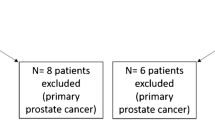Abstract
Men treated for prostate cancer with curative intent face a recurrence rate of up to 53% at 10 years. 68Ga-PSMA imaging is a new technique that can more accurately stage cancer recurrences and facilitate personalised treatment. We evaluated the cost-effectiveness of 68Ga-PSMA PET/MRI for staging men with prostate cancer biochemical recurrence. A cost-effectiveness analysis using a decision-analytic model with Markov chains was constructed. 68Ga-PSMA PET/MRI was compared with usual care in staging of men with suspected prostate cancer recurrence. Men with biochemical recurrence from a study in Brisbane, Australia (n = 30) provided key estimates for the model. The primary outcomes were health system costs and years of life (survival) over 10 years. Deterministic and probabilistic sensitivity analyses were undertaken to address uncertainty in model estimates. On average, a strategy of 68Ga-PSMA was expected to cost AU$56 961(US$39 426) and produce 7.48 life years compared with AU$64 499 (US$44 667) and 7.41 life years in usual care. Therefore, 68Ga-PSMA was potentially cost saving (− AU$7 592 95% UI − $24 846, $7 825) (− US$5 258) and slightly more effective 0.07 life years (95% UI − 0.01, 0.16). The likelihood that 68Ga-PSMA strategy was cost-effective at acceptable thresholds was 87%. The findings were sensitive to the lesion detection rate of the 68Ga-PSMA strategy (52–75%) and the cost of follow up in usual care (AU$1 947 to $2 635). In this exploratory economic evaluation, using 68Ga-PSMA PET/MRI to detect prostate cancer recurrence appears to be cost-effective relative to usual care.



Similar content being viewed by others
References
Taitt HE (2018) Global trends and prostate cancer: a review of incidence, detection, and mortality as influenced by race, ethnicity, and geographic location. Am J Men's Health 12(6):1807–1823
Artibani W et al (2018) Management of biochemical recurrence after primary curative treatment for prostate cancer: a review. Urol Int 100(3):251–262. https://doi.org/10.1159/000481438
Pisansky TM et al (2019) Adjuvant and salvage radiotherapy after prostatectomy: ASTRO/AUA guideline amendment 2018–2019. J Urol 202(3):533–538
Lenzo NP, Meyrick D, Turner JH (2018) Review of gallium-68 PSMA PET/CT imaging in the management of prostate cancer. Diagnostics (Basel, Switzerland) 8(1):16
Hofman MS et al (2018) A prospective randomized multicentre study of the impact of gallium-68 prostate-specific membrane antigen (PSMA) PET/CT imaging for staging high-risk prostate cancer prior to curative-intent surgery or radiotherapy (proPSMA study): clinical trial protocol. BJU Int 122(5):783–793. https://doi.org/10.1111/bju.14374
Fendler WP et al (2019) Assessment of 68Ga-PSMA-11 PET accuracy in localizing recurrent prostate cancer: a prospective single-arm clinical trial. JAMA Oncol 5(6):856–863
Sathianathen NJ, Butaney M, Konety BR (2018) The utility of PET-based imaging for prostate cancer biochemical recurrence: a systematic review and meta-analysis. World J Urol 37(7):1239–1249
Husereau D et al (2013) Consolidated health economic evaluation reporting standards (CHEERS) statement. Int J Technol Assess Health Care 29(2):117–122
Weinstein MC et al (2003) Principles of good practice for decision analytic modeling in health-care evaluation: report of the ISPOR Task Force on Good Research Practices-Modeling Studies. Value Health 6(1):9–17
Afshar-Oromieh A et al (2015) The diagnostic value of PET/CT imaging with the (68)Ga-labelled PSMA ligand HBED-CC in the diagnosis of recurrent prostate cancer. Eur J Nucl Med Mol Imaging 42(2):197–209. https://doi.org/10.1007/s00259-014-2949-6
Michalski JM et al (2018) Effect of standard vs dose-escalated radiation therapy for patients with intermediate-risk prostate cancer: the NRG oncology RTOG 0126 randomized clinical trial. JAMA Oncol 4(6):e180039
James ND et al (2016) Failure-free survival and radiotherapy in patients with newly diagnosed nonmetastatic prostate cancer: data from patients in the control arm of the STAMPEDE trial. JAMA Oncol 2(3):348–357
Pommier P et al (2016) Is there a role for pelvic irradiation in localized prostate adenocarcinoma? Update of the long-term survival results of the GETUG-01 randomized study. Int J Radiat Oncol Biol Phys 96(4):759–769
Shipley WU et al (2017) Radiation with or without antiandrogen therapy in recurrent prostate cancer. N Engl J Med 376(5):417–428
Klotz L et al (2015) Long-term follow-up of a large active surveillance cohort of patients with prostate cancer. J Clin 33(3):272–277
Messing EM et al (2006) Immediate versus deferred androgen deprivation treatment in patients with node-positive prostate cancer after radical prostatectomy and pelvic lymphadenectomy. Lancet Oncol 7(6):472–479
The Australian Department of Health (2018). https://www.mbsonline.gov.au/internet/mbsonline/publishing.nsf/Content/Home. MBS Online. vol. 27/08/2018, Accessed 27 Aug 2018
Pharmaceutical Benefits Scheme (2018). www.pbs.gov.au/pbs/home. Accessed 20 Oct 2018
(MSAC) MSAC (2012) MSAC application 1158: final decision analytic protocol (DAP) to guide the assessment of robotic image-guided stereotactic precise beam radiosurgery and radiotherapy for prostate cancer. MSAC. vol 01/09/2018, pp 25–26
Reeve R et al (2018) Health care use and costs and the end of life: a comparison of elderly Australian decedents with and without a cancer history. BMC Palliat Care. https://doi.org/10.1186/s12904-017-0213-0
Rowe SP et al (2016) PSMA-based [(18)F]DCFPyL PET/CT is superior to conventional imaging for lesion detection in patients with metastatic prostate cancer. Mol Imaging Biol 18(3):411–419
Acknowledgements
The trial was funded by a Princess Alexandra Hospital Research Foundation New Appointment Grant for imaging and the ANZUP/TOLMAR Clinical Research Fellowship for translational research awarded to Dr Vela. Dr Vela is supported by a Movember Clinician Scientist Award awarded through the Prostate Cancer Foundation of Australia’s Research Program.
Author information
Authors and Affiliations
Corresponding author
Additional information
Publisher's Note
Springer Nature remains neutral with regard to jurisdictional claims in published maps and institutional affiliations.
Electronic supplementary material
Below is the link to the electronic supplementary material.
Rights and permissions
About this article
Cite this article
Gordon, L.G., Elliott, T.M., Joshi, A. et al. Exploratory cost-effectiveness analysis of 68Gallium-PSMA PET/MRI-based imaging in patients with biochemical recurrence of prostate cancer. Clin Exp Metastasis 37, 305–312 (2020). https://doi.org/10.1007/s10585-020-10027-1
Received:
Accepted:
Published:
Issue Date:
DOI: https://doi.org/10.1007/s10585-020-10027-1




